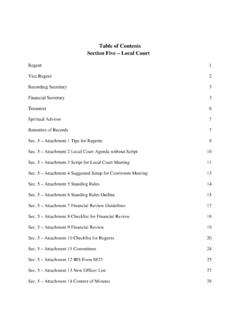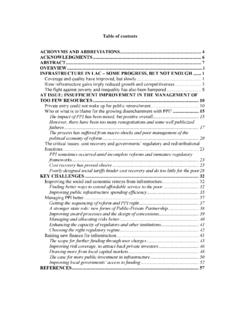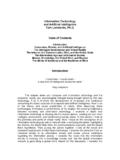Transcription of Table of Contents Section Seven – Parliamentary …
1 Table of Contents Section Seven Parliamentary Procedure Points On Parliamentary Procedure 1 Classification of Motions 2 Main Motion 2 Incidental Main Motions 2 Incidental Motions 3 Subsidiary Motions 3 Privileged Motions 4 7 - 1 P. O. P. P. Points On Parliamentary Procedure I make a or should it be I I need to ask a question, should I do it now or later? I would like our Court to donate some money to a very worthy cause, what should, I do? We ve all heard questions similar to these at one time or another. Many of our members are hesitant to participate in court meetings because they are not comfortable with Parliamentary procedure.
2 Many of our court meetings are not productive because we do not use Parliamentary procedure to provide an avenue for active discussion and decision-making. Points on Parliamentary Procedure When used, P. O. P. P. is one of the most effective tools that can be used by Regents, officers, and members of the Catholic Daughters. Depending on the level of skills that members have, courts can use simple, informal and formal Parliamentary procedures to navigate and to facilitate decision-making. Parliamentary Procedure refers to the rules of democracy-that is, the commonly accepted way in which a group of people come together, present and discuss possible courses of action, and make decisions.
3 Fundamentally, Parliamentary procedure defines how groups, no matter how formal or informal, can most effectively make decisions in a fair, consistent manner and make good use of everyone s time. Motion- A motion is a request that something be done or that something is the opinion or wish of the group. Only one motion should be placed before the group at one time. It is debatable and amendable. A motion should be stated as I move Second-Someone from the group must second the motion, or agree to the motion so that it can be discussed. If the motion is coming from a Committee, it does not need a second.
4 Discussion- The motion on the floor is discussed by all members, addressing the pros and the cons, etc. Re-State the Motion-The Regent or presiding officer re-states the motion before the group votes. Vote-The group votes by voice-aye/no; by show of hands; by standing; by secret ballot; or by roll call vote. 7 - 2 Classification of Motions Motions may be classified as: Main Motions; Incidental Motions; Privileged Motions; and Subsidiary Motions. Subsidiary Who? Privileged When? And, Incidental How? What in the world are you talking about? Main Motions A Main Motion is a motion made to bring before the Court, for its consideration, of any particular subject.
5 It takes precedence of nothing. That is, it cannot be made when any other question is before the Court. Main Motions yield to all Incidental, Privileged and Subsidiary Motions. Main motions are debatable and are subject to amendment. Main motions can be subdivided into Original Main Motions and Incidental Main Motions. Original Main Motions are those which bring before the Court some new subject, generally in the form of a resolution upon which action by the Court is desired. Incidental Main Motions are those main motions that are incidental to, or relate to, the business of the Court, or its past or future action, as, a committee s report on a resolution referred to it.
6 A motion to accept or adopt the report of a standing committee upon a subject not referred to it is an original main motion. But a motion to adopt or accept a report that was referred to the committee is an incidental main motion. The only difference between the two classes of main motions is that an objection to consider the motion cannot be applied to an incidental main motion. A two-thirds vote can sustain an original motion from consideration. Incidental Main Motions Accept or Adopt a Report upon a subject referred to a committee Adjourn at, or to, a future time Adjourn, if qualified in any way, or to adjourn when the effect is to dissolve the assembly with no provision for its reconvening Appoint the Time and Place for the next meeting, if introduced when no business is pending Amend the Constitution, By-laws, Standing Rules or Resolutions, etc.
7 Already adopted Ratify or Confirm action taken Rescind or Repeal action taken 7 - 3 Incidental Motions Incidental Motions are motions that arise out of another question which is pending, and, therefore, takes precedence and must be decided before the question out of which they arise; or, they are incidental to question that has just been pending and should be decided before any other business is taken up. For the most part, they are not debatable and cannot be amended, except where they relate to the division of a question, or to the method of considering a question, or methods of voting, or to the time when nominations or the poll shall be closed.
8 Incidental motions take precedence of subsidiary motions. The following list comprises most of the Incidental Motions that may arise. Remember: Incidental motions to object to the consideration of a question cannot be made while a subsidiary motion is pending, as the objection is only legitimate against an original main motion just after it is stated, before it has been debated or there has been any subsidiary motion stated. Incidental Motions Question of Order and Appeal Suspensions of the Rules Objections to the Consideration of a Question Division of a Question Division of the Assembly and Motions relating to Method of Voting or to Closing or Reopening the Nominations Motions relating to Methods of Making, or to Closing or to Reopening Nominations Request growing out of Business Pending or that has just been pending.
9 As, a Parliamentary Inquiry, a Request for Information, for Leave to Withdraw a Motion, to Read Papers, to be Excused from a Duty, or for any other Privilege Subsidiary Motions Subsidiary Motions are such as are applied to other motions for the purpose of most appropriately disposing of them. By means of a subsidiary motion, the original motion may be modified, or action postponed, or it may be referred to a committee to investigate and report, etc. They may be applied to any main motion and when made, they supersede the main motion and must be decided before the main motion can be acted upon.
10 Subsidiary motions, except to lay on the Table , the previous question, and postpone indefinitely, may be amended. The following list of subsidiary motions is arranged in the order of their precedence, the first one having the highest rank. Subsidiary Motions Lay on the Table The Previous Question Limit or Extend Limits of Debate Postpone Definitely or to a Certain Time Commit or Refer, or Recommit Amend Postpone Indefinitely 7 - 4 Privileged Motions Privileged Motions are such as, while not relating to the pending question, are of so great importance as to require them to take precedence of all questions, and, on account of this high privilege, they are not debatable.










